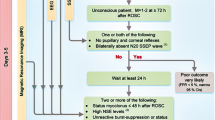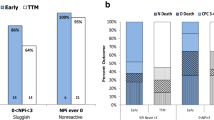Abstract
Background
Sedation and therapeutic hypothermia (TH) delay neurological responses and might reduce the accuracy of clinical examination to predict outcome after cardiac arrest (CA). We examined the accuracy of quantitative pupillary light reactivity (PLR), using an automated infrared pupillometry, to predict outcome of post-CA coma in comparison to standard PLR, EEG, and somato-sensory evoked potentials (SSEP).
Methods
We prospectively studied over a 1-year period (June 2012–June 2013) 50 consecutive comatose CA patients treated with TH (33 °C, 24 h). Quantitative PLR (expressed as the % of pupillary response to a calibrated light stimulus) and standard PLR were measured at day 1 (TH and sedation; on average 16 h after CA) and day 2 (normothermia, off sedation: on average 46 h after CA). Neurological outcome was assessed at 90 days with Cerebral Performance Categories (CPC), dichotomized as good (CPC 1–2) versus poor (CPC 3–5). Predictive performance was analyzed using area under the ROC curves (AUC).
Results
Patients with good outcome [n = 23 (46 %)] had higher quantitative PLR than those with poor outcome [n = 27; 16 (range 9–23) vs. 10 (1–30) % at day 1, and 20 (13–39) vs. 11 (1–55) % at day 2, both p < 0.001]. Best cut-off for outcome prediction of quantitative PLR was <13 %. The AUC to predict poor outcome was higher for quantitative than for standard PLR at both time points (day 1, 0.79 vs. 0.56, p = 0.005; day 2, 0.81 vs. 0.64, p = 0.006). Prognostic accuracy of quantitative PLR was comparable to that of EEG and SSEP (0.81 vs. 0.80 and 0.73, respectively, both p > 0.20).
Conclusions
Quantitative PLR is more accurate than standard PLR in predicting outcome of post-anoxic coma, irrespective of temperature and sedation, and has comparable prognostic accuracy than EEG and SSEP.



Similar content being viewed by others
References
Hypothermia after Cardiac Arrest Study Group. Mild therapeutic hypothermia to improve the neurologic outcome after cardiac arrest. N Engl J Med. 2002;346:549–56.
Bernard SA, Gray TW, Buist MD, et al. Treatment of comatose survivors of out-of-hospital cardiac arrest with induced hypothermia. N Engl J Med. 2002;346:557–63.
Kurz MC. For whom the bell tolls. Resuscitation. 2011;82:1371–2.
Wijdicks EF, Hijdra A, Young GB, Bassetti CL, Wiebe S. Practice parameter: prediction of outcome in comatose survivors after cardiopulmonary resuscitation (an evidence-based review): report of the Quality Standards Subcommittee of the American Academy of Neurology. Neurology. 2006;67:203–10.
Samaniego EA, Mlynash M, Caulfield AF, Eyngorn I, Wijman CA. Sedation confounds outcome prediction in cardiac arrest survivors treated with hypothermia. Neurocrit Care. 2011;15:113–9.
Tortorici MA, Kochanek PM, Poloyac SM. Effects of hypothermia on drug disposition, metabolism, and response: a focus of hypothermia-mediated alterations on the cytochrome P450 enzyme system. Crit Care Med. 2007;35:2196–204.
Rossetti AO, Oddo M, Logroscino G, Kaplan PW. Prognostication after cardiac arrest and hypothermia: a prospective study. Ann Neurol. 2010;67:301–7.
Al Thenayan E, Savard M, Sharpe M, Norton L, Young B. Predictors of poor neurologic outcome after induced mild hypothermia following cardiac arrest. Neurology. 2008;71:1535–7.
Fugate JE, Wijdicks EF, Mandrekar J, et al. Predictors of neurologic outcome in hypothermia after cardiac arrest. Ann Neurol. 2010;68:907–14.
Rossetti AO, Urbano LA, Delodder F, Kaplan PW, Oddo M. Prognostic value of continuous EEG monitoring during therapeutic hypothermia after cardiac arrest. Crit Care. 2010;14:R173.
Rundgren M, Westhall E, Cronberg T, Rosen I, Friberg H. Continuous amplitude-integrated electroencephalogram predicts outcome in hypothermia-treated cardiac arrest patients. Crit Care Med. 2010;38:1838–44.
Cloostermans MC, van Meulen FB, Eertman CJ, Hom HW, van Putten MJ. Continuous electroencephalography monitoring for early prediction of neurological outcome in postanoxic patients after cardiac arrest: a prospective cohort study. Crit Care Med. 2012;40:2867–75.
Bouwes A, Binnekade JM, Kuiper MA, et al. Prognosis of coma after therapeutic hypothermia: a prospective cohort study. Ann Neurol. 2012;71:206–12.
Kamps MJ, Horn J, Oddo M, et al. Prognostication of neurologic outcome in cardiac arrest patients after mild therapeutic hypothermia: a meta-analysis of the current literature. Intensiv Care Med. 2013;39:1671–82.
Oddo M, Rossetti AO. Predicting neurological outcome after cardiac arrest. Curr Opin Crit Care. 2011;17:254–9.
Larson MD, Muhiudeen I. Pupillometric analysis of the ‘absent light reflex’. Arch Neurol. 1995;52:369–72.
Meeker M, Du R, Bacchetti P, et al. Pupil examination: validity and clinical utility of an automated pupillometer. J Neurosci Nurs. 2005;37:34–40.
Yan S, Tu Z, Lu W, et al. Clinical utility of an automated pupillometer for assessing and monitoring recipients of liver transplantation. Liver Transplant. 2009;15:1718–27.
Behrends M, Niemann CU, Larson MD. Infrared pupillometry to detect the light reflex during cardiopulmonary resuscitation: a case series. Resuscitation. 2012;83:1223–8.
Oddo M, Rossetti AO. Early multimodal outcome prediction after cardiac arrest in patients treated with hypothermia. Crit Care Med. 2014; Jan 22 (Epub ahead of print).
Engel H, Ben Hamouda N, Portmann K, et al. Serum procalcitonin as a marker of post-cardiac arrest syndrome and long-term neurological recovery, but not of early-onset infections, in comatose post-anoxic patients treated with therapeutic hypothermia. Resuscitation. 2013;84:776–81.
Cueni-Villoz N, Devigili A, Delodder F, et al. Increased blood glucose variability during therapeutic hypothermia and outcome after cardiac arrest. Crit Care Med. 2011;39:2225–31.
Rossetti AO, Carrera E, Oddo M. Early EEG correlates of neuronal injury after brain anoxia. Neurology. 2012;78:796–802.
Phelps R, Dumas F, Maynard C, Silver J, Rea T. Cerebral performance category and long-term prognosis following out-of-hospital cardiac arrest. Crit Care Med. 2013;41:1252–7.
Perman SM, Kirkpatrick JN, Reitsma AM, et al. Timing of neuroprognostication in postcardiac arrest therapeutic hypothermia. Crit Care Med. 2012;40:719–24.
Yannopoulos D, Kotsifas K, Aufderheide TP, Lurie KG. Cardiac arrest, mild therapeutic hypothermia, and unanticipated cerebral recovery. Neurologist. 2007;13:369–75.
Friberg H. Neurological prognostication after cardiac arrest. Scand J Trauma Resusc Emerg Med. 2008;16:10.
Sandroni C, Cavallaro F, Callaway CW, et al. Predictors of poor neurological outcome in adult comatose survivors of cardiac arrest: a systematic review and meta-analysis. Part 2: patients treated with therapeutic hypothermia. Resuscitation. 2013;84:1324–38.
Peberdy MA, Callaway CW, Neumar RW, et al. Part 9: post-cardiac arrest care: 2010 American Heart Association Guidelines for Cardiopulmonary Resuscitation and Emergency Cardiovascular Care. Circulation. 2010;122:S768–86.
Nielsen N, Wetterslev J, Cronberg T, et al. Targeted temperature management at 33 °C versus 36 °C after cardiac arrest. N Engl J Med. 2013;369:2197–206.
Acknowledgments
The authors thank Helena Marti-Soler, Ph.D., for independent review of statistical analysis, and Christine Stähli, RN and Elsa Juan, MPsych, for her help in data acquisition. This work was supported by grants from the Swiss National Science Foundation (to MO and AOR), the European Critical Care Research Network (to MO), and the Gueules Cassées Foundation (to PB).
Conflict of interest
The authors have no conflict of interest to declare. The manufacturer of automated pupillometry (IDMED) was not involved in the study.
Author information
Authors and Affiliations
Corresponding author
Additional information
Tamarah Suys and Pierre Bouzat contributed equally.
Rights and permissions
About this article
Cite this article
Suys, T., Bouzat, P., Marques-Vidal, P. et al. Automated Quantitative Pupillometry for the Prognostication of Coma After Cardiac Arrest. Neurocrit Care 21, 300–308 (2014). https://doi.org/10.1007/s12028-014-9981-z
Published:
Issue Date:
DOI: https://doi.org/10.1007/s12028-014-9981-z




